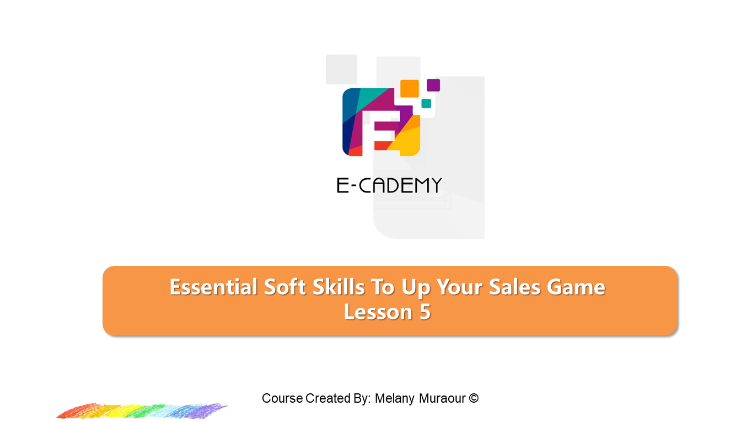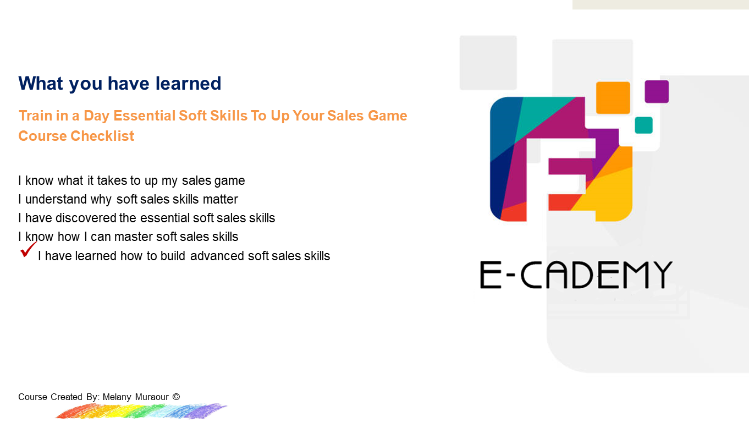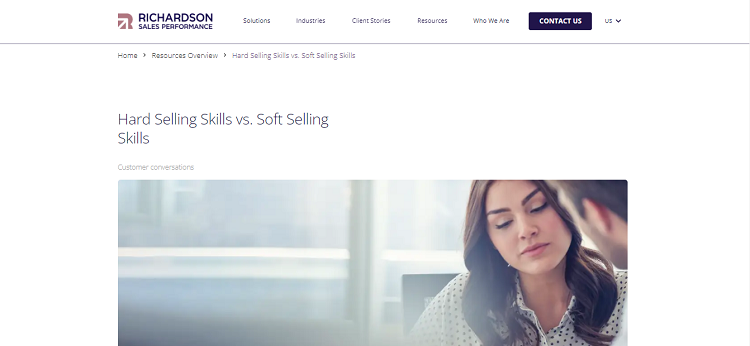Lesson 5: How you can build advanced soft sales skills

Let’s Get Started!

3 ways to gain advanced soft sales skills
- Build your empathy muscle in sales
- Tell stories
- Integrate soft sales skills with hard sales skills
1. Build your empathy muscle in sales
What is empathy?
Empathy is the ability to perceive what others are feeling and thinking without having to express it verbally.
Every one of us unconsciously sends out signals about our emotions through tone of voice, gestures, facial expressions, breathing rates, etc. There is a little area within our brain in charge of detecting these signals from the entire body, and empathetic people are able to use these signals to figure out which state the other person is in.
Why is it important to be empathetic?
Empathetic people are known to be much more effective at communicating, at all levels, which is not only critical to enjoying great social relationships but also offers many benefits in the working environment – empathetic people can easily interpret the motivations of each of their team members, and therefore ensure that their team always gives their best. Empathetic people also adapt quickly to situations and new environments.
Here are 3 steps to build your “empathy muscle”
Commit to improve
Think about what benefits you will get if you become more empathetic. More sales? Improved social relationships? Better synergy within your team? You need to find your own motive, and then use it as a valuable opportunity to wield empathy in every possible situation.
Focus your objective on day to day situations
Choose times when you’re meeting with members of your team in the workplace to rehearse and sharpen your empathy skills. During these moments, as well as discussing pertinent issues, concentrate on your feelings and perceptions about the emotional state of the other person/people present.
Think about:
- Are they happy today?
- What’s their energy level like?
- Do they seem nervous? Preoccupied?
- Have they listened to you properly or does it seem like they’re thinking about something else?
- Do they trust me?
Get feedback
Get feedback about every one of your feelings or hunches about the emotional state of the other person. This is a vital step, because not only do you want to practice, but you also want to improve and start properly figuring out other people’s feelings. Don’t be shy to ask your colleagues, friends, and family for feedback – they have valuable info that can help you become more on the ball in showing empathy. Just hone in on what you will achieve if you become more empathetic. Bring this to the front of your mind so that you don’t get embarrassed or insecure when you may feel unmasked around other people.
How you relate empathy to sales…
Being empathetic and listening effectively is all about putting your focus on the prospect rather than on your own agenda, thoughts, and feelings, with the purpose of gaining a deep understanding of our prospect´s needs, problems, and vision as well as building trust-based relationships with them.
When it comes to sales, you should:
1. Use every sales call as an opportunity to learn empathy/listening skills
2. Put your attention on the other person´s body language (tone of voice, pace, pauses, emotions behind the words). Try to figure out your prospect´s emotions behind their words. Use your intuition, your gut. Think about what is not being said here?
3. After the sales call ask yourself: how does this person feel/think about this sales opportunity? On a scale from 0 to 10, how interested do I think/ feel/see they are at this point in the sales cycle? What objections/ doubts/ fears could they have?
4. After the next call with this person ask yourself and consider how accurate your perceptions about your prospect were
2. Tell stories
Everyone who is passionate about sales gets a kick from a close. But how do you get that kick more often? Storytelling is an effective method that every sales professional should have in their toolbox.
Storytelling handles 2 typical challenges in sales:
Challenge 1
Getting decision-makers to take time to listen. Attention spans are getting shorter and shorter and distractions pop up constantly. It’s shocking but true: at 9 seconds, the attention span of a goldfish is now longer than that of most human beings!
Challenge 2
It’s no secret that gut feel plays a big role in the decision-making process. The tricky part: how do you speak to someone’s gut? Facts and figures play a role, but these are usually used to justify decisions made on an emotional level. Storytelling gives you a tool for combining both rational and emotional sales triggers.
As a salesperson, you should have several sales stories you can rely on during the sales process.
When you can and should use sales storytelling:
To Make Your Presentation More Conversational
When you’re formulating a sales presentation, do you think the facts are enough to persuade people to buy? If you deliver parrot-fashioned information without connecting, the info can fall apart. In fact, presentations without stories often make prospects feel that you are talking at them – not with them – which puts up a wall between you. This drives them away and you don’t want to drive them away, do you?
By making sales stories “hero’s journey”s with the prospect at its crux, you can personalize the information you’re offering, make data more understandable, turn facts into gripping plot points, and help make details stick. You can also help make the sales process more of a conversation – and less of a presentation.
To Establish Credibility
If you can get a prospect to trust you, you have a chance to persuade them that your product is available from the outset.
To establish credibility, start your sales pitch by telling stories that talk about previous successes. This is proof that your product is worth the investment – because you’ve already delivered results.
Business storytelling expert and author of Putting Stories to Work Shawn Callahan sums up the importance of using previous sales stories to signify credibility. Shawn explains, that a sales story “demonstrates that you, first of all, understand what their needs are– that you’ve dealt with them before and that you’ve successfully helped somebody through the process.”
Stories don’t only help buyers see that what you’re selling works. They also show that you’re an insightful and credible expert. It shows that you know the ins and outs of your company and its history. That you’re equipped with sufficient knowledge to be trusted.
To Handle Objections
One popular sales storytelling technique for objection handling is called “Feel, Felt, Found” — a central strategy in Apple’s Genius Training manual. During “Feel, Felt, Found,” you:
- Acknowledge how a prospect feels when they convey any objections
- Relay a story about how a former customer felt a similar way
- Wrap the story with how that customer “found” their solution by purchasing your product
The “Feel, Felt, Found” method works because it starts by establishing empathy. Then it relays a digestible, tangible story that feels relevant and helpful. It encourages a prospect to come over to your side (and buy).
Garin Hess, CEO of Consensus, describes the “Feel, Felt, Found” sales storytelling technique by calling it “verbal judo.” He says “when we get an objection in sales, instead of resisting, we need to move right with it. An objection necessarily, at first, places our prospect on one side and you on the other. The end goal is to get on the same side, and resistance keeps us on opposite sides… The key to effectively using this framework is to be sincere… You are there to help them solve a problem, not to get the deal. If you solve their problem, they will buy. Using Feel, Felt, Found as verbal judo will take the opposition out of the objection and help you move to a more collaborative discussion to build the right value.”
What Kind of Sales Stories You Can Use:
It’s important to build up an arsenal of stories. These can be deployed when you’re trying to sell. Here are a few types of stories to have in your bag of tricks when you’re persuading a prospect to buy:
Previous customer success stories
Stories of previous customer successes can be powerful tools. They can convince your prospects that they need to purchase what you’re selling. A study by Gartner showed that 70% of executive buyers maintain that customer stories are the best way to set a company apart from its competitors. This means that if you’ve memorised and rehearsed tales of how you’ve led your previous customers to success, you’ll probably end up bringing in new customers in no time!
Personal anecdotes
You can use personal anecdotes to create common ground with the people you’re selling to. This common ground between sellers and buyers creates empathy and this naturally creates a feeling of trust.
Company failures
It might seem contradictory, but telling failure stories is actually an effective way to sell. Failure stories can call attention to situations in which your company has grown and improved. It can also make you seem more credible and honest. Aaron Kotick, Managing Director of Deal IQ Inc. and former president of Fusion Learning, believes “failure stories are a great way to build empathy – nobody likes to fail, and people feel for you when you tell one. It’s a way to build trust and connections.”
Selling isn’t simple science. One of the most effective tools for optimising the process is using sales tales. Sales stories paint you as a subject expert. They make your information relatable and engaging. And, they provide motivation for buyers to take action.
If you’re in sales, it’s time you step away from boring presentations and pitches filled with data and start building an armory of sales stories to use when you want someone to buy. You may also find that your sales process is smoother, more effective, and also much more enjoyable than ever before.
3. Integrate soft sales skills with hard sales skills
The differences between hard selling and soft selling come down to one factor: father time 😉
A hard sell is an attempt to get the buyer to take action now.
In contrast, a soft sell is an unhurried approach.
When you adopt soft selling you’ll be taking your time. You’ll be learning about the customer, their needs, concerns, and perceptions of value. Hard selling is rarely concerned with these details. As a result, hard selling is often more transactional in nature and characterised by forceful action aimed to get the buyer to make a purchase. This sales approach is rarely appropriate.
Given the major contrast between these two methods, it is clear that soft selling is far more effective in the long run. So, why is it important to differentiate hard selling skills from soft selling skills? Because you need to understand both so that you’ll be aware of instances when you accidentally resort to a hard sell approach that might risk the sale.
Although covered in more depth in lesson 1, we’ll quickly examine these two sales techniques by illustrating the differences between the two and showing why soft selling is the more effective approach below:
Hard selling skills
Hard selling skills put most of the emphasis on making a sale fast. The hard sell happens in the moment. Therefore the only skills that apply to the hard sale are those that you believe will address the customer’s latest stated need.
Hard selling skills are often seen when you’re aiming for volume, not value. That is, you’re trying to get a commitment from the buyer fast so that you can move to your next sale. The shortcoming of this approach is that it often leaves your buyer feeling pressured and uneasy…. and most likely not wanting to do business with you again.
Hard selling is not effective for a solution that has any degree of sophistication or complexity because these details cannot be discussed in one sales conversation. Often a simple, easy-to-understand product or service is best-suited for a hard sell. Moreover, a hard sell often aims to focus the customer on urgency by articulating the potential opportunity cost of not buying. Hard selling prioritises product knowledge over communication skills. The hard-sell approach doesn’t attempt to follow a sales process. Instead, a hard sell pushes your customer to buy your product.
In many cases hard selling is something that emerges when an otherwise patient sales professional feels that they are short on time. Few sales managers coach their sales team to use hard selling tactics. Instead, hard selling is the result of looming sales targets and drifting deals.
Soft selling skills
Soft selling skills focus on building rapport with customers. With this approach, you’ll be taking the time to learn about your customer’s needs, their concerns, and the network of stakeholders involved in the buying decision. Soft selling requires emotional intelligence (EQ) which allows you to have empathy and an understanding of your customer’s financial and reputational risks involved in making the purchase.
The biggest and best benefit of soft selling skills is that they address all aspects of your customer’s buying journey. Early in the journey, soft skills help guide the conversation with a set of questions that help both you and the customer to better understand their needs.
Later, when you are ready to present a solution, your soft skills again will come into play as you’ll need to effectively connect the solution capabilities to the customer’s specific needs.
Finally, during the negotiations, your soft skills will be needed to help you to overcome customer objections, protect the financial value of the sale, and engage in an effective trading strategy.
Many of the complex needs and solutions that are increasingly seen require team members to leverage soft skills. These selling scenarios involve too many factors, people, and changes to be addressed with a hard-sell approach. This is why you must be able to discover and combine an array of information to properly present and pitch a sophisticated solution.
Additionally, soft-selling fosters settings where white space opportunities can be probed. If you push the sale with hard-sell tactics there is no possibility for relationship growth. There is no opportunity to pursue the conversation because no conversation has started. White space is found in the undertone and detail of the conversation. The speed of a hard sell doesn’t allow for nuances to be heard.
To sum it all up, sales success requires that you draw on a set of skills that can be leveraged in the right places throughout the sales cycle. Doing this requires soft selling skills and these skills build over a career. But there is no reason why you can’t put them to work fast – all you need to do is simply start asking questions, building rapport, and offering meaningful insights to your customer throughout the sales dialogue.
Good luck! 🍀
Download Extra Notes
“Hard Selling Skills vs. Soft Selling Skills”
For extra reading, click on the image below to get the PDF or click here to read this article covering “Hard Selling Skills vs. Soft Selling Skills” by richardsonsalestraining.
Summary


